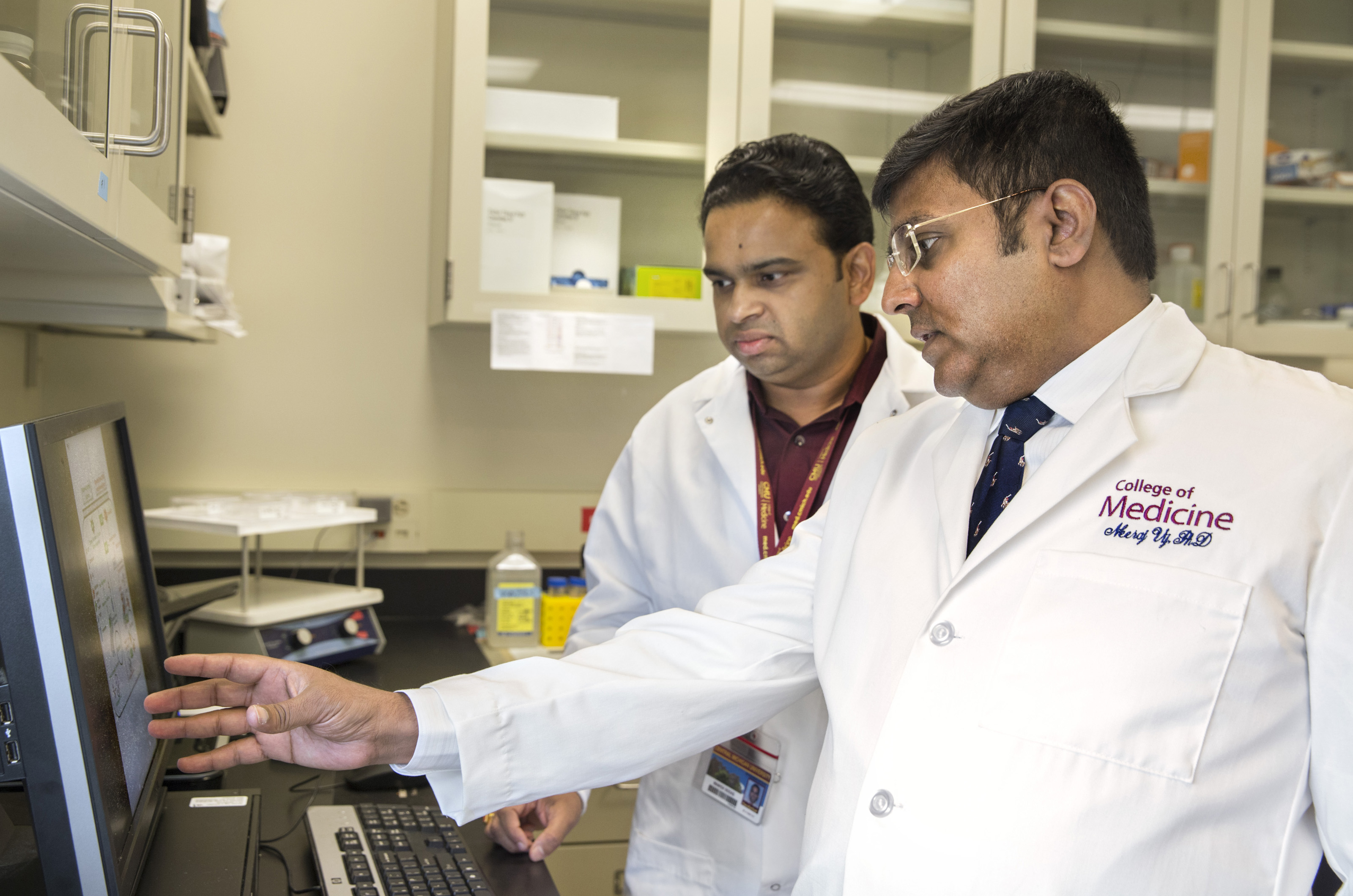
Dr. Neeraj Vij, right, discusses the nanodelivery process with CMU postdoctoral researcher Manish Bodas.
Like a cyclist weaves in and around stalled rush-hour traffic, a novel delivery method called nanodelivery carries drugs through the body directly to their destination cells without getting lost along the way.
In a new study, a Central Michigan University College of Medicine researcher used nanodelivery to target drugs directly at affected or diseased cells within the lungs without harming the healthy cells around them. This method could treat patients with cystic fibrosis, chronic obstructive pulmonary disorder and lung cancer without the side effects.
“Using cystic fibrosis and COPD as a model, we wanted to target delivery to specific cell types within the lungs,” says Neeraj Vij, associate professor of molecular and cell biology. “Blockage in a patient’s airway can lead to cellular destruction, infection and an overall decline in lung function. If we can treat this, we can improve quality of life for these people and control the symptoms of these diseases more effectively.”
Pediatric cystic fibrosis and other obstructive lung diseases such as emphysema and asthma are treated by drugs delivered by inhalation. This can pose a challenge, however, when a buildup of mucus blocks the airway in patients with these ailments. Vij’s nanodelivery system works through this buildup to target only the cells which need to be treated.
“A considerable challenge we faced with cystic fibrosis was access in obstructive airway diseases,” Vij says. “These patients have thick mucus and inflammation within the lungs, but the nanoparticles help bypass this and deliver anti-inflammatory and other drugs and get into the lungs where the affected cells live.”
“Moreover, we can use a nano-based strategy to treat the underlying cause of the disease,” he says.
Vij’s study was published in Nanomedicine: Nanotechnology, Biology and Medicine. Nanodrug delivery is a relatively new way of approaching a variety of disorders such as COPD-emphysema, chronic bronchitis, asthma and cystic fibrosis. COPD alone is the third-leading cause of mortality in the U.S.
“This is the first time we were able to test the specific approach inside lungs,” he says. “We are very excited as it has potential for further development.”
In traditional chemotherapy, drugs are targeted to an area, not specific cells. This treatment is often considered aggressive, particularly when used in the lungs. Vij’s nanodelivery, however, attacks only the bad cells, limiting the damage caused to surrounding tissues.
“Anytime you change the cell, you have side effects,” says Vij. “We want to treat the bad cells and kill them, but if treatment is too aggressive it will kill everything — including the surrounding healthy cells. This is the problem with many chemotherapy treatments.”
Vij also recently published in PLOS One Scientific Journal about using nanotechnology to deliver a drug that can target specific cancer cells to effectively stop them from multiplying. Nanodelivery technology is not a new concept in medicine. Though it is used in some cancer treatments and imaging methods, it was not developed enough to be used in cystic fibrosis and COPD patients until recently.
Vij has already seen the potential of nanodelivery as a viable strategy for treating some types of lung cancer and as a method for the treatment of lung diseases.
Last week, Vij published an expert opinion on drug delivery, linking the treatment to potentially decrease lung inflammation caused by cigarette smoke. His research in this area links together his history of studies tying e-cigarettes to emphysema and his discovery of a predictive marker for advanced lung diseases. The potential for nanodelivery is only now being recognized, he says.
“We also can use imaging modality within this delivery method to get a real-time assessment of the state of the disease, efficacy of drugs and even make a diagnosis,” Vij says.
Vij and his team members from Johns Hopkins University School of Medicine and CMU’s College of Medicine were supported by grants from the Cystic Fibrosis Foundation, Flight Attendant Medical Research Institute, and the National Institutes of Health.
Source: Central Michigan University




